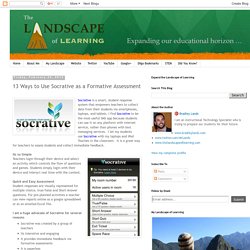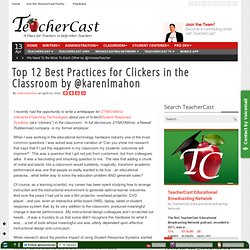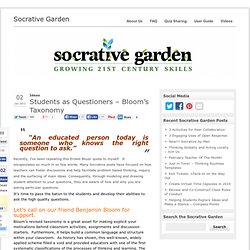

The Landscape: 13 Ways to Use Socrative as a Formative Assessment. Socrative is a smart, student response system that empowers teachers to collect data from their students via smartphones, laptops, and tablets.

I find Socrative to be the most useful SMS app because students can use it on any platform with internet service, rather than phones with text messaging services. I let my students use Socrative with my laptops and iPod Touches in the classroom. It is a great way for teachers to assess students and collect immediate feedback. Its so Simple Teachers login through their device and select an activity which controls the flow of questions and games. Quick and Easy Assessment Student responses are visually represented for multiple choice, true/false and Short Answer questions. EVIDENTIAL REASONING: Visible Thinking Routine 2. What Makes You Say That?

As you know, Socrative is a tool that reports what your students know. However, did you know that Socrative can also provide information on how your students are thinking? For example, after a science lesson, a teacher may use a Socrative quiz to ask, “Will a penny, with a density of 2g/ml float in water?” Based upon the student responses, the teacher will be able to see who responded correctly. Then, she may ask, “Please explain your answer to question 1″. Here’s where another component of student thinking comes in. This type of teaching is based upon research on student thinking at Harvard’s Project Zero. What’s going on? Because the basic questions in this routine are flexible, it is useful when looking at objects such as works of art or historical artifacts, but it can also be used to explore a poem, make scientific observations and hypothesis, or investigate more conceptual ideas. Socrative Solution Short Response Quiz Multiple Choice. Making Thinking Visible with Socrative.
Project Zero, an educational research group at Harvard’s Graduate School of Education, has been working to enhance student learning, thinking and creativity since the 1960s.

Founded by the philosopher Nelson Goodman it’s impacted global education and been guided by such education luminaries as Howard Gardner and David Perkins. Utilizing it’s core concepts and adding a dash of Socrative will bolster student reflection, critical thinking, and creativity while developing independent learners for the 21st century. Let’s Dig In! What are Visible Thinking Routines? At the core of Visible Thinking are practices that help make thinking visible:Thinking Routines loosely guide learners’ thought processes and encourage active processing.
Visible Thinking Routine 1 – HEADLINES This routine draws on the idea of newspaper-type headlines as a vehicle for summing up and capturing the essence of an event, idea, concept, topic, etc. Gathering Feedback With Socrative Classroom Activities. Workarounds for Clipping Web Pages into Evernote on iOS. Top 12 Best Practices for Clickers in the Classroom by @karenlmahon. I recently had the opportunity to write a whitepaper for DYMO/Mimio InteractiveTeaching Technologies about use of hi-techStudent Response Systems (aka “clickers”) in the classroom.

In full disclosure, DYMO/Mimio, a Newell Rubbermaid company, is my former employer. When I was working in the educational technology hardware industry one of the most common questions I was asked was some variation of “Can you show me research that says that if I put this equipment in my classroom my students’ outcomes will improve?”
This was a question that I got not just from customers, but from colleagues alike. It was a fascinating and shocking question to me. The idea that adding a chunk of metal and plastic into a classroom would suddenly, magically, transform academic performance was one that people so badly wanted to be true…an educational panacea…what better way to solve the education problem AND generate sales? Top 12 Best Practices for Clickers in the Classroom 1. 2. 3. 4. 5. 6. 7. 8. 9. 10. 11. Students as Questioners – Bloom’s Taxonomy. “An educated person today is someone who knows the right question to ask.”

Recently, I’ve been repeating this Ernest Boyer quote to myself. It encapsulates so much in so few words. Many Socrative posts have focused on how teachers can foster discussions and help facilitate problem based thinking, inquiry and the surfacing of main ideas. Consequently, through modeling and drawing student attention to your questions, they are aware of how and why you are asking particular questions. It’s time to pass the baton to the students and develop their abilities to ask the high quality questions. 4 Interactive Tips to Jumpstart Summer School. Summer school is its own entity all together!

In addition, this may be your first summer with a tech enriched classroom…or it could be if you try some Bring Your Own Technology (BYOT) Lessons. Here are some ideas for using Socrative and Tech in your Lessons Icebreakers Introduce the students to each other and their technology. Prepare fun Multiple Choice and True False questions for the board, Powerpoint. In the weightlessness of space, if a frozen pea touches Pepsi it will explode? True FalseMen are 4 times more likely to be struck by lightning than women. True False The worlds smartest pig memorized the multiplication table up to 12. Just In Time Activities – with 3 Shareable templates.
While putting the “final touches” on a lesson plan, I was struck with a decision about the class ending activity.

I know students will have questions and concerns about the readings and projects. I wanted the freedom and flexibility to choose the culminating activity in the moment.